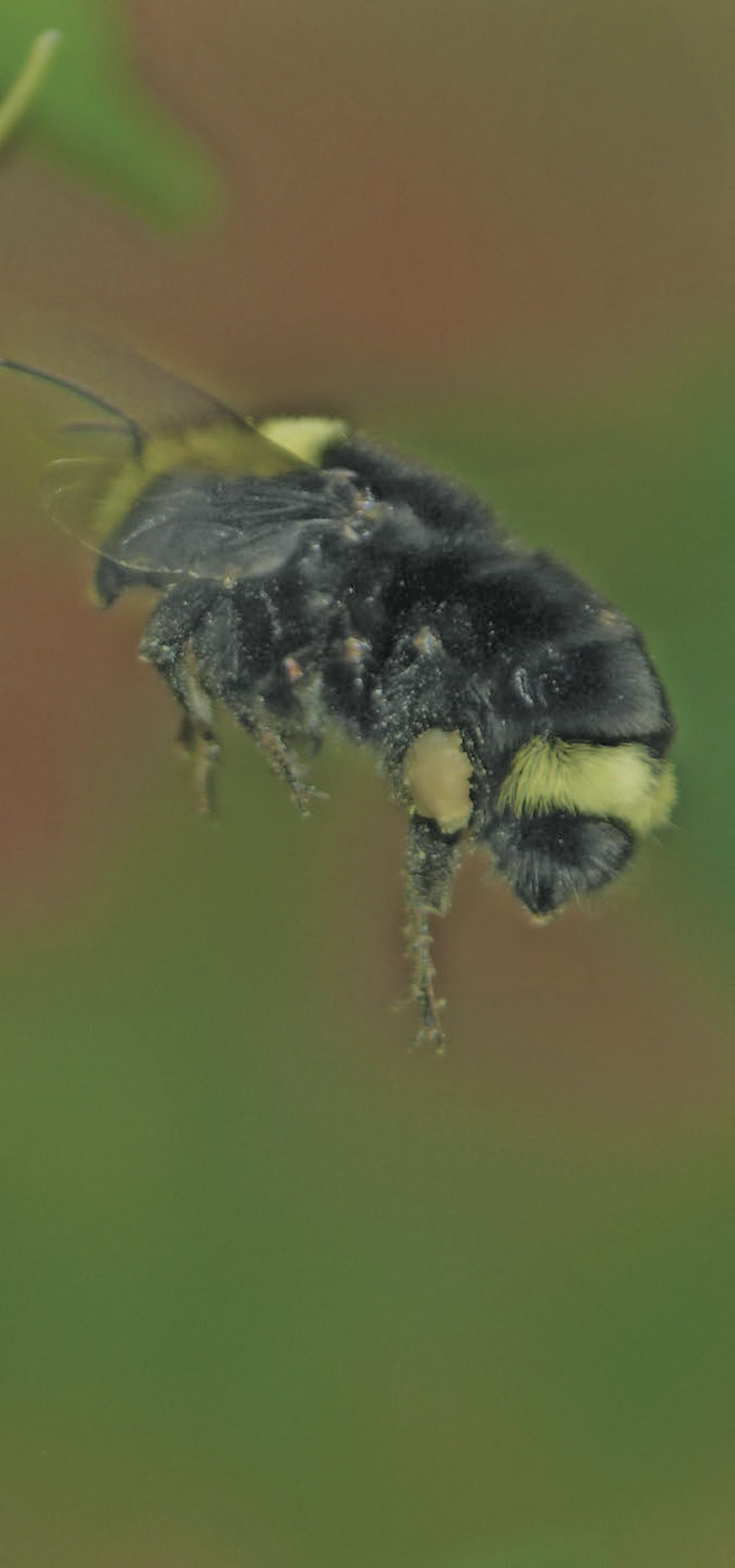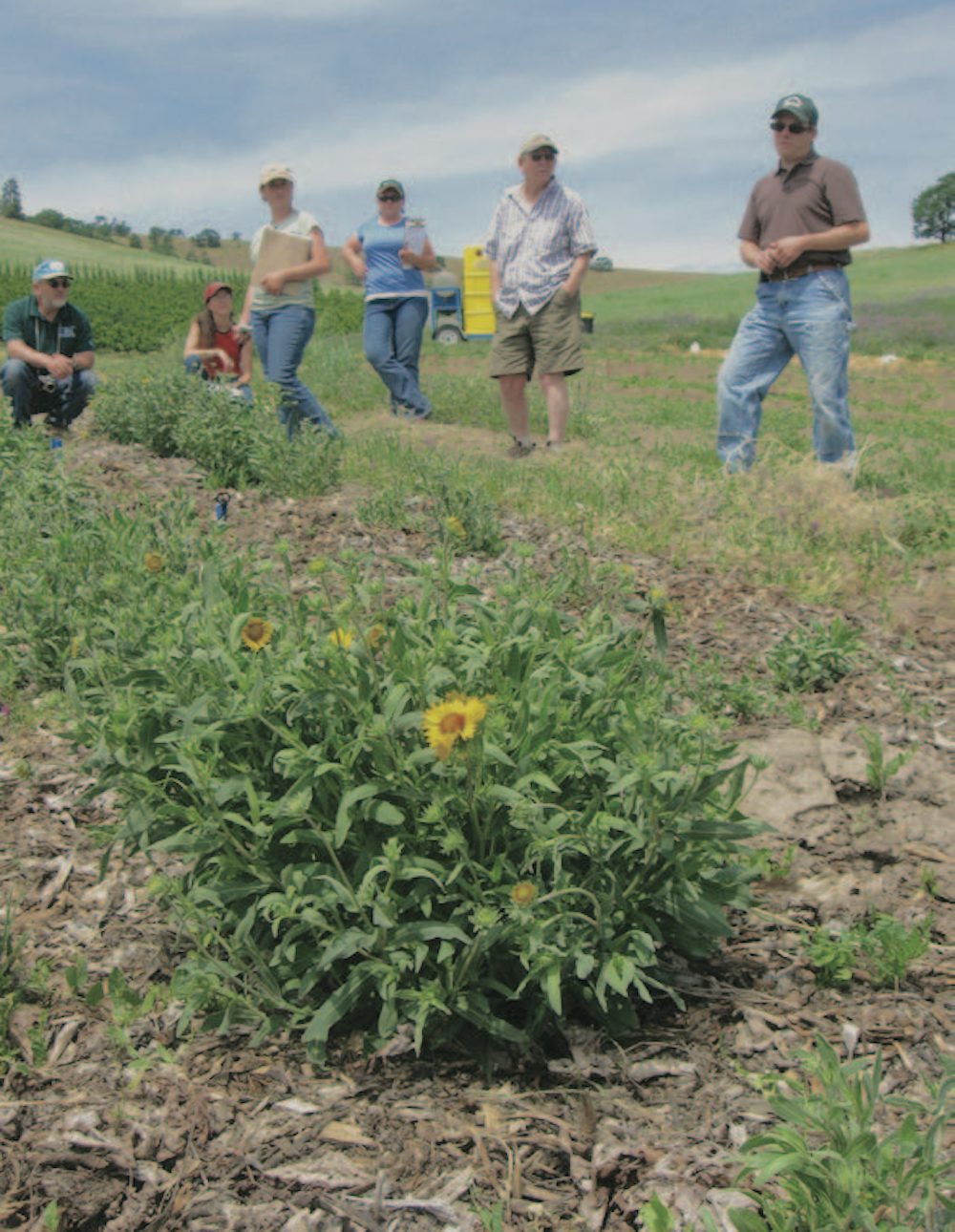On the Omeg family’s Oregon cherry orchard, a 10-foot perimeter of goldenrod, catmint and blanket flower surrounds the 350 acres of trees. The flowers run between the rows, too, and in one section of the orchard, four 30-foot diameter circular patches sport a host of native prairie grasses that produce flowers of their own. It’s a lovely display, but Mike Omeg, the fifth-generation family member who now runs the orchard, didn’t work untold hours just to make his farm prettier. The flowers host several species of bumblebee, orchard mason bees and sweat bees, all of which are, well, busy as bees, as they fly from blossom to blossom doing what they’re uniquely qualified for—pollinating food crops.
Years after scientists first noticed that a mysterious insect plague known as colony collapse disorder was wiping out honeybees around the globe, a precise cause has yet to be determined. Scientists regard a number of factors that have emerged and combined over the past few decades to be deadly combination for bees, contributing to CCD and other “beekills.” While research continues, many small and midsize farms have been taking action by enlisting more bees to pollinate their crops by luring them in with food, water and custom- made habitat. Their success could be an important component to averting a pollination crisis—and increasing food security worldwide.
The concern over the dramatic drop in the world bee population isn’t just about honey. In fact, about one-third of all food crops worldwide depend on insect pollination. Everything from almonds to apples to cucumbers to soybeans. At least $235 billion are at risk globally.

Ever since people first began to cultivate food crops, bees have been pollinating many of them. and until very recently, the job was done efficiently and free of charge by whatever pollinating insects were native to the area. “When our landscape was more diverse, pollinators had plenty of varied habitat,” explained Eric Mader, national pollinator outreach coordinator of the Xerces Society, a nonprofit devoted to invertebrate conservation. In the past, a wider variety of wildflowers, trees and grasses bloomed at different times of year and provided a steady stream of pollen and nectar for wild bees. Farms also provided food and shelter, since most rotated food and cover crops like clover. But the landscape of most industrialized countries—and, increasingly, developing ones—has changed drastically over the past 60 years.
Small family farms with several different crops have largely given way to large, single-crop fields, and pesticide use has increased dramatically. At the same time, undeveloped natural areas that might have harbored wild bees are shrinking or disappearing. Also, there’s the double whammy of pesticides. Insecticides aimed at wiping out harmful insects can often do the same to bees. Even small exposures can put severe stress on their immune systems, leaving them vulnerable to diseases. “And then you have the herbicides that are killing the weeds, but it turns out that bees need weeds for food,” said May Berenbaum, entomologist at the University of Illinois.
The beekeeping business has also been changing. Before World War II, there were about half a million colonies of managed honeybees in the United States. They were raised not only for their honey, but also for wax, which was widely used for everything from candles to the waterproof coating on raincoats for the U.S. military. Though they were fed and housed by beekeepers, they also helped themselves to the nectar and pollen from surrounding plants. “Back then, a beekeeper might pay a farmer a small rental fee to keep them on his land, or maybe just let them loose in a natural area,” said Kim Flottum, editor of the trade journal Bee Culture and a beekeeper himself.
Farmers must now pay beekeepers to deliver colonies to their fields for pollination services during the crucial window when their crops are in bloom.
But in the 1950s, the United States started to import cane sugar. Petroleum products began to replace beeswax. Changes in trade policies caused the price of imported Chinese honey to drop to competitive levels. As a result, demand for U.S. honey fell dramatically and now supports only about half as many managed colonies. At the same time, the number of acres devoted to pollination-dependent crops doubled in the United States. “So now we have about half the bees and twice the work,” Mader said. And of course, this is on top of the decline in wild bees. As a result, farmers must now pay beekeepers to deliver colonies to their fields for pollination services during the crucial window when their crops are in bloom. Such services are in high demand—instead of a beekeeper paying a farmer, U.S. growers are now paying thousands for honeybee rentals. In western Europe and most of the developing world, native pollinator declines have also led farmers to rely on honeybee rentals.
It wasn’t until 2006 that two things brought the plight of bees to light—the emergence of colony collapse disorder (CCD) and a report from the National Research Council on the decline of North American wild and domestic pollinators. The council’s report was one of the first sources to document major losses of domesticated bees and reveal evidence of dramatic declines of wild ones. It warned of impending agricultural consequences. That same year, beekeepers across the U.S. began to see a strange, scary phenomenon in their hives. Entire colonies of adult bees would vanish without a trace, leaving the queen and young brood behind. “There have always been lots of things that kill bees—mites or disease, for example. But then you usually see dead bees. With true CCD, they’d just disappear,” Flottum said. Beekeepers continue to lose bees at an alarming rate – though reports of CCD have dwindled since 2007, from April 2018 – April 2019, beekeepers still lost 40.7% of their honey bee colonies.
Meanwhile, other countries also began to see dramatic declines in both honeybees and wild pollinators—some of which fit the colony collapse disorder pattern and some of which had other hallmarks. “We’ve seen a lot of cyclical declines over the years, but not like this. We call it CCD sometimes just because we don’t know what else to call it, but the point is, around the world, bees are in trouble,” said Gabriella Chavarria, a conservation biologist with the Natural Resources Defense Council.
In North America, entomologists are still zeroing in on the exact causes behind colony collapse disorder, but almost everyone agrees that a perfect storm of factors is responsible. “Not only do you have habitat degradation, but you have globalization, which allows imported bees to bring diseases in more readily, and then of course [you have] pesticides,” said Berenbaum, whose research pinpointed one of the specific viruses involved. But no matter what’s behind colony collapse disorder, the important lesson to be learned may be that our current environment is simply leaving bees too vulnerable. “It’s like this,” explained Flottum. “if you’re healthy and you walk into an elevator and someone sneezes, you probably won’t get sick. But if you haven’t been eating well, you’ve been stressed, overworked, in crowded conditions for weeks or months, breathing in chemicals, and you walk into that same elevator and someone sneezes, well, you probably will.”

Most experts agree that the key to avoiding the next pollination crisis will be to make the world a better place for bees in general. That’s where strategies such as Oregon orchardist Mike Omeg’s pollinator habitat idea come in. “We can’t put the genie back in the bottle, but we can integrate some of the best practices from the past into what we’ve learned about the future,” said Claire Kremen, a conservation biologist at the University of California, Berkeley. Kremen is one of a small cadre of pollination experts who have researched ways to bolster native bees.
Motivated by both colony collapse disorder and the 2006 National Research Council findings, the Xerces Society culled existing research on pollinators and produced detailed guidelines for farmers in several different states, which the group has promoted since 2007. Momentum Mader and other scientists from the group also visit farms to make specific recommendations based on climate, geography and existing growth.
“Eric [Mader] came out on a cold day last winter and walked around the farm with me. then we sat around the kitchen table and came up with a plan,” said Deirdre Birmingham, who farms 60 acres of organic cider apples in Wisconsin. With Mader’s help, she decided to plant spruce trees and barberry shrubs as a windbreak, both of which provide habitat for bees. “This was something I was going to have to do anyway, so now I’m just getting more bang for my buck, and it doesn’t cut into my acreage at all,” Birmingham said. She also planted a small prairie of Indian grass and little bluestem, as well as wildflowers like purple coneflower, evening primrose, goldenrod and brown-eyed Susans. The prairie attracts mason bees and other wild bees and provides nectar and pollen for the four hives of honeybees Birmingham and her husband raise.
“Ultimately, what we need to do is think about how to change farming itself, and we’ll need a range of strategies to do it.” – Claire Kremen, conservation biologist
Another major benefit is that such habitat also attracts beneficial insects that are natural predators to pests. “I haven’t had to treat for cabbage worms in five years,” said Harriet Behar, an organic vegetable farmer also in Wisconsin. Behar’s 300-acre farm includes a 10-acre meadow that she is working to rehabilitate with help from the Xerces Society and a state agency devoted to sustainable farming. She’s noticed better yields in the areas near the meadow and has seen plenty of new wild bees and beneficial insects buzzing around on her farm.
She also uses other tactics, like rotating her food crops with clover, to make her farm bee friendly. “When you have a diverse ecosystem like this, you might get problem insects for a short time, but then you have an army of beneficials ready to attack and eat them,” explained Behar, who attributed her lack of cabbage worms to the parasitic wasps living in the meadow. And though organic farms may have the most interest in chemical-free pest control, conventional farms also stand to benefit, too. “A lot of the farmers interested in doing this are organic or otherwise embracing sustainable agriculture, but we’re also just attracting those paying a lot to rent honeybees,” Mader said.
Proponents stress that this approach is likely only a part of what’s needed to restore the world’s pollinators to safe levels—but it may be that it’s the part that’s been missing so far. “Ultimately, what we need to do is think about how to change farming itself, and we’ll need a range of strategies to do it,” Kremen said. Other approaches have also found some success: Improved nutrition and more aggressive parasite and disease management have also done some good. In Europe, aggressive pesticide management has been the primary strategy, with Germany and France banning certain pesticides and Spain and the United Kingdom expected to follow.
A positive side effect of colony collapse disorder was the increase in international discussion on the best ways to improve the environment to counter the global pollination crisis, Flottum said. “Research support had really dwindled over the years,” he said. But headlines about the disorder motivated scientists to investigate causes and solutions. And farmers are beginning to see, from a bee’s perspective, the beauty in a diverse and colorful landscape.
Story by Sarah Schmidt, a freelance writer based in Brooklyn, N.Y. Her work has appeared in the New York Times, New York Magazine, One Earth and Plenty. This article first appeared in Summer World Ark 2010.